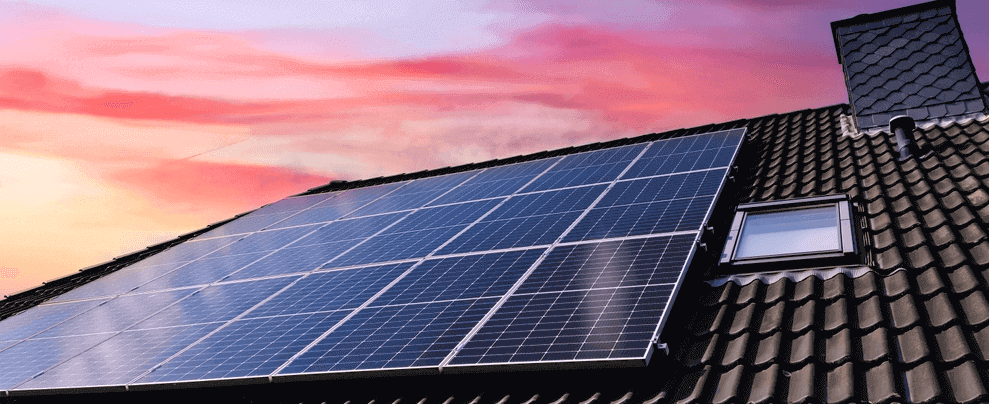KEY POINTS
- North is generally considered the best direction for solar panels to face in Australia.
- Other factors, including a home’s location, latitude and surrounding terrain also affect the best orientation for solar panels.
- Households closer to the equator may find it beneficial to have little to no tilt on their solar panels, as the sun is typically higher in the sky.
The sun doesn’t stay in one spot in the sky throughout the day, meaning you need to position solar panels carefully to ensure they make the most of their time in the sun. But what is the best orientation for solar panels?
Discover the best position, direction and angle for your solar panels with this Canstar Blue guide.
On this page:
Advertisement
What is the best direction for solar panels to face?
There’s plenty of things to consider when installing solar panels, such as their long-term power savings, the brand and type of panels to purchase and how many you need. Your choice of installer also needs careful thought. But once you’ve researched all your purchasing decisions, there’s one more crucial factor to consider: the best direction for your solar panels to face.
North is generally considered the best direction for solar panels to face in Australia (and the rest of the Southern Hemisphere). This is because exposure to sunlight during the middle hours of the day is greater when facing in this direction.
However, facing panels true north isn’t always the best option. Other factors, including a home’s location, latitude and surrounding terrain also affect the best orientation for solar panels, along with other variables, such as:
- Shading: nearby trees or buildings can cast shade during certain times of the day, negatively affecting any solar panels caught in their shadows
- Cloud cover: areas that usually experience overcast mornings may find westward facing solar panels more effective
- Hours of peak electricity consumption: If you’re not at home much during the day, and consume most of your electricity in the mornings and evenings, it may be better to align some of your panels facing to the east and west, to make the most of the morning and afternoon sun
If you’re planning to install solar panels on your roof, chances are you won’t have much choice about the direction they face, as you’ll have to conform to the structure and design of your roof. But if you’re building or renovating and thinking about putting solar panels on your roof down the line, it might be worth factoring in which direction will work best for your panels once they’re installed.
At what angle should my solar panels be set?
The angle at which your solar panels are installed will affect how much sunlight they capture. Therefore, the slant of your roof and the latitude of your home need to be taken into account when calculating the angle of your panels.
As a general rule of thumb, solar panels should be installed at an angle that is similar to their latitude, to ensure they capture the most light as the sun moves through the sky. For example, Sydney has a latitude of around 34 degrees, so it’s recommended that solar panels in Sydney are installed at a 34-degree angle towards the sun for maximum effectiveness. However, the angle at which you can install your solar panels will depend on the slant of your roof.
Compare solar energy plans
Here are some of the cheapest solar-specific deals from the retailers on our database. These costs are based on the Ausgrid network in Sydney but prices will vary depending on your circumstances. We show one product per retailer, listed in order of lowest price first. Annual price estimates assume general energy usage of 3900kWh/year for a residential customer on a single rate tariff. Price estimates exclude solar feed-in tariff credits. These are products from referral partners†. Our database may not cover all deals in your area, and please check retailer websites for up to date information.
Here are some of the cheapest solar-specific deals from the retailers on our database. These costs are based on the Citipower network in Melbourne but prices will vary depending on your circumstances. We show one product per retailer, listed in order of lowest price first. Annual price estimates assume general energy usage of 4000kWh/year for a residential customer on a single rate tariff. Price estimates exclude solar feed-in tariff credits. These are products from referral partners†. Our database may not cover all deals in your area, and please check retailer websites for up to date information.
Here are some of the cheapest solar-specific deals from the retailers on our database. These costs are based on the Energex network in Brisbane but prices will vary depending on your circumstances. We show one product per retailer, listed in order of lowest price first. Annual price estimates assume general energy usage of 4600kWh/year for a residential customer on a single rate tariff. Price estimates exclude solar feed-in tariff credits. These are products from referral partners†. Our database may not cover all deals in your area, and please check retailer websites for up to date information.
Here are some of the cheapest solar-specific deals from the retailers on our database. These costs are based on SA Power network in Adelaide but prices will vary depending on your circumstances. We show one product per retailer, listed in order of lowest price first. Annual price estimates assume general energy usage of 4000kWh/year for a residential customer on a single rate tariff. Price estimates exclude solar feed-in tariff credits. These are products from referral partners†. Our database may not cover all deals in your area, and please check retailer websites for up to date information.
Should solar panels on flat roofs be tilted?
The short answer is yes, but it may not be necessary in every case. For example, those who live closer to the equator – such as those in the top end of Australia – may find it more beneficial to have little to no tilt on their solar panels, as the sun is always higher in the sky. Those with limited roof space may also potentially be restricted as to how they install their panels.
However, if you don’t fall into the above two categories, installing your solar panels at an angle similar to your latitude should help increase your solar output.
Also, solar panels are generally always installed with a slight tilt to help with rainwater runoff, meaning you’ll rarely see a completely horizontal solar panel.
Is it worth investing in a solar tracker?
A solar tracker is a mechanical device that attaches to a solar panel and allows it to track the sun across the sky, maximising sunlight exposure.
Solar trackers cost a minimum of a few thousand dollars to purchase and install, meaning they’re not a cost-effective option for most residential users. However, if you own a commercial property with a large number of solar panels, or you’re looking to power your home almost entirely on solar power, then a solar tracker may be a worthwhile investment.
Articles you may be interested in:
Does solar panel direction matter?
Given that solar panels only work if they’re exposed to sunlight, their positioning has a direct impact on their effectiveness, and how much you can potentially save on your energy bill.
As a result, if you want to gain maximum efficiency from your solar panels, you should carefully consider the direction you face them and the angle at which they are set. However, there’s no point setting your heart on facing them in a certain direction if your roof can’t support it, or there are trees blocking the sun.
Ultimately, the direction in which you position your solar panels will depend on your home and individual circumstances. So always discuss your needs with your solar installers, who should work with you to ensure you get the most effective system for your needs and energy usage.
If you’re keen to whack some panels on your rooftop, be sure to check out our solar panel installer ratings below. Click on the button to discover the installers that everyday Aussies have rated the best.
Original reporting by Jared Mullane
Image Source: MP_Foto/Shutterstock




Share this article